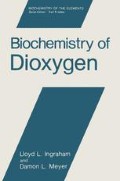Abstract
Certain exothermic chemical reactions produce light instead of heat. Chemiluminescent reactions also occur in living systems. The term usually used for light production from living systems is bioluminescence. Fireflies, bacteria, and other organisms produce bioluminescence.
Access this chapter
Tax calculation will be finalised at checkout
Purchases are for personal use only
Preview
Unable to display preview. Download preview PDF.
Reference
Adam, W., 1975. Biological light: a-Peroxylates as bioluminescent intermediates, J. Chem. Ed52: 138–145.
Anderson, J. A., 1980. Biochemistry of centipede bioluminescence, Photochem. Photobiol. 31:179–181. Baumstark, A. L., Cline, T. W., and Hastings, J. W., 1979. Reversible steps in the reaction of
aldehydes with bacterial luciferase intermediates, Arch. Biochem. Biophys. 193:449–455.
Dunn, D. K., Michaliszyn, G. A., Bogacki, I. G., and Merghen, E. A., 1973. Conversion of aldehyde to acid in the bacterial bioluminescent reaction, Biochemistry12: 4911–4918
Hart, R. C., Stempel, K. E., Boyer, P. D., and Cormier, M. J., 1978. Mechanism of the enzyme- catalyzed bioluminescent oxidation of coelenterate-type luciferin, Biochem. Biophys. Res. Commun81: 980–986.
Hastings, J. W., and Balny, C., 1975. The oxygenated bacterial luciferase intermediate, J. Biol. Chem250: 7288–7293.
Hastings, J. W., and Gibson, Q. H., 1963. Intermediates in the bioluminescent oxidation of reduced flavin mononucleotide, J. Biol. Chem238: 2537–2554.
Hastings, J. W., Balny, C., LePeuch, C., and Douzou, P., 1973. Spectral properties of an oxygenated luciferase-flavin intermediate isolated by low temperature chromatography, Proc. Natl. Acad. Sci. U.S.A70: 3468–3472.
Kemal, C., and Bruice, T. C., 1976. Simple synthesis of a 4a-hydroperoxy adduct of a 1,5- dihydroflavin: Preliminary studies of a model for bacterial luciferase, Proc. Natl. Acad. Sci. U.S.A73: 995–999.
Kemal, C., Chan, T. W., and Bruice, T. C., 1977. Chemiluminescent reactions and electrophilic oxygen donating ability of 4a-hydroperoxyflavins: General synthetic method for the preparation of N5-alkyl-1, 5-dihydroflavins, Proc. Natl. Acad. Sci. U.S.A74: 405.
Kishi, T., Goto, T., Inoue, S., Suguira, S., and Kishimoto, H., 1966. Cypridina bioluminescence. III. Total synthesis of Cypridina luciferin, Tetrahedron Lett. 29: 3445–3450.
Koka, P., and Lee, J., 1979. Separation and structure of the prosthetic group of the blue fluorescence protein from the bioluminescent bacterium Photobacterium phosphoreum, J. Biol. Chem. 76: 3068–3072.
Kopecky, K. R., and Mumford, C., 1969. Luminescence in the thermal decomposition of 3, 3, 4- trimethyl-1, 2-dioxetane, Can. J. Chem47: 709–711.
Lowe, J. N., Ingraham, L. L., Alspach, J., and Rasmussen, R., 1976. A proposed symmetry forbidden oxidation mechanism for the bacterial luciferase catalyzed reaction, Biochem. Biophys. Res. Commun73: 465–469.
McCapra, F., 1970. The chemiluminescence of organic compounds, PureAppl. Chem24: 611–629.
McCapra, F., and Hysert, D. W., 1973. Bacterial bioluminescence—identification of fatty acid as product, its quantum yield and a suggested mechanism, Biochem. Biophys. Res. Commun52: 298–304.
Merghen, E. A., and Hastings, J. W., 1971. Binding site determination from kinetic data: Reduced flavin mononucleotide binding to bacterial luciferase, J. Biol. Chem246: 7666–7674.
Schuster, G. B., 1979. Chemiluminescence of organic peroxides: Conversion of ground state reactants to excited state products by the chemically initiated electron exchange luminescence mechanism, Acc. Chem. Res12: 366–373.
Shepherd, P. T., and Bruice, T. C., 1980. Formation of a nonchemiluminescent excited state species in the decomposition of 4a(alkylperoxy) flavins, J. Am. Chem. Soc102: 7774–7776.
Shimomura, O., and Johnson, F. H., 1971. Mechanism of the luminescent oxidation of Cypridina luciferin, Biochem. Biophys. Res. Commun44: 340–346.
Shimomura, O., Johnson, F. H., and Kohama, Y., 1972. Reactions involved in bioluminescence systems of limpet (Latia neritoides) and luminous bacteria, Proc. Natl. Acad. Sci. U.S.A69: 2086–2089.
Shimomura, O., Goto, T., and Johnson, F. H., 1977. Source of oxygen in the C02 produced in the bioluminescent oxidation of firefly luciferin, Proc. Natl. Acad. Sci. U.S.A74: 2799–2802.
Tu, S.-C., 1979. Isolation and properties of bacterial luciferase-oxygenated flavin intermediate complexed with long-chain alcohols, Biochemistry18: 5940–5945.
Turro, N. J., and Lechtken, P., 1972. Thermal decomposition of tetramethyl-1, 2-dioxetane: Selective and efficient chemelectronic generation of triplet acetone, J. Am. Chem. Soc94: 2886–2888.
White, E. H., and Worther, H., 1966. Analogs of firefly luciferin III, J. Org. Chem31: 1484–1488.
White, E. H., McCapra, F., Field, G. F., and McElroy, W. D., 1961. The structure and synthesis of firefly luciferin, J. Am. Chem. Soc83: 2402–2403.
White, E. H., Worther, H., Seliger, H. H., and McElroy, W. D., 1966. Amino analogs of firefly luciferin and biological activity thereof, J. Am. Chem. Soc88: 2015–2019.
White, E. H., Miano, J. D., and Umbreit, M., 1975. On the mechanism of firefly luciferin luminescence, J. Am. Chem. Soc97: 198–200.
White, E. H., Steinmetz, M. G., Miano, J. D., Wildes, P. D., and Morland, R., 1980. Chemi and bioluminescence of firefly luciferin, J. Am. Chem. Soc. 102: 3199–320
Author information
Authors and Affiliations
Rights and permissions
Copyright information
© 1985 Plenum Press, New York
About this chapter
Cite this chapter
Ingraham, L.L., Meyer, D.L. (1985). Bioluminescenc. In: Biochemistry of Dioxygen. Biochemistry of the Elements, vol 4. Springer, Boston, MA. https://doi.org/10.1007/978-1-4613-2475-1_19
Download citation
DOI: https://doi.org/10.1007/978-1-4613-2475-1_19
Publisher Name: Springer, Boston, MA
Print ISBN: 978-1-4612-9501-3
Online ISBN: 978-1-4613-2475-1
eBook Packages: Springer Book Archive

